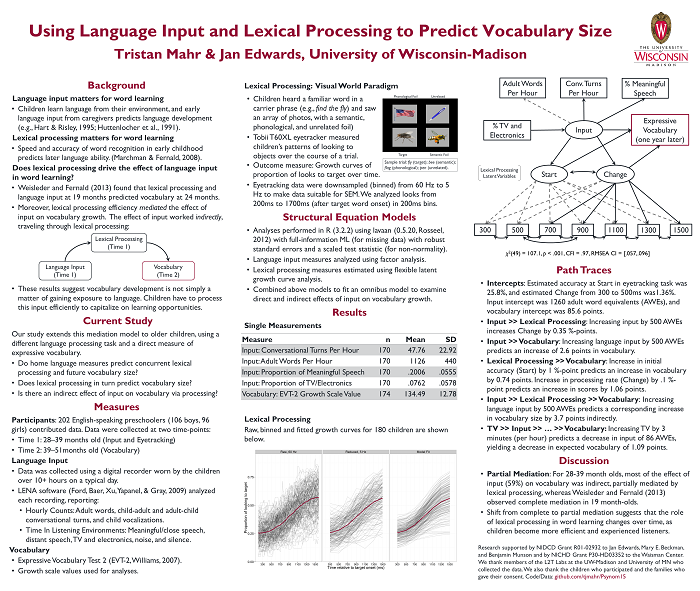Poster presented at 56th Annual Meeting of the Psychonomic Society (Nov. 2015 in Chicago, IL)
data: data-sets used in the modelsposter: the poster as printed and presented at the conferenceR: helper R scriptreports: a "full-text" write-up companion to the posterreport.md: Final, rendered form of write-upreport.Rmd: RMarkdown file used to generate write-up (text + code to run)compile.R: R script to build the html version of write-up
Title: Using Language Input and Lexical Processing to Predict Vocabulary Size
Authors: Tristan Mahr and Jan Edwards
Your Presentation Time: 6:00-7:30 p.m.
Poster Viewing Time: 4:00–7:30 p.m.
Session Information: Poster Session I, Thursday Evening, November 19, 2015, Salon B
Abstract: Children learn words by listening to caregivers, and the quantity and quality of early language input predict later language development. Recent research suggests that lexical processing efficiency may mediate the relationship between input and vocabulary growth. We asked whether language input and lexical processing at 28-39 months predicted vocabulary size one year later in 180 preschoolers. Input was measured using adult word counts, conversational turn counts, and proportion of meaningful speech and television in the child’s environment. Lexical processing was measured using accuracy and rate of change on a four-image looking-while-listening eyetracking task. Structural equation modeling showed that both input and lexical processing predicted vocabulary size, but most of the effect of input was mediated by lexical processing. Further, amount of television in the environment negatively influenced vocabulary size. These results further support the hypothesis that children must efficiently process ambient language input to capitalize on learning opportunities.
Abstract Number: 1165
Abstract Numbering You will note that the abstract number assigned to your poster is a 4-digit number. The first digit codes which session you were assigned to (1–5; 1 = Thursday evening; 2 = Friday noon; 3 = Friday evening; 4 = Saturday noon; 5 = Saturday evening). The last 3 digits range between 001 and
- These digits code your poster location (i.e., 001 is poster #1 within the session; 002 is poster #2, etc.). So, for example, 4016, is in the Saturday noon session, board #16. The boards will be grouped serially in the room to help participants locate specific presentations.
